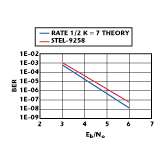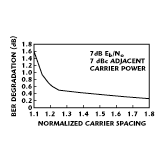A Variable Data Rate VSAT Broadband Receiver
Stanford Telecom,
Telecom Component Products Group
Sunnyvale, CA
Very small aperture terminal (VSAT) system suppliers are constantly seeking ways to keep their systems flexible and up-to-date with current and future data rate requirements. In addition, there is constant pressure to reduce system size and weight and lower system costs. These demands drive system designers to seek increased levels of component integration and more modular system construction, allowing rapid changes and upgrades as the market and technology demand.
A new variable data rate digital demodulator receiver assembly has been developed to simplify VSAT receiver system design. The model STEL-9258 is a board-level demodulator receiver for single-channel-per-carrier signals in audio, data and video broadcast applications. The demodulator is integrated easily into many system applications and offers a fast and effective design solution when data rate requirements increase. The receiver's variable data rate allows the VSAT system to operate at the lowest possible bandwidth, thereby saving significant cost.
The receiver includes an integral L-band downconverter that can be tuned from 950 to 1450 MHz in 1 Hz steps and operates at an input level of -70 to -40 dBm. The minimum signal-to-noise ratio is 3 dB, and the carrier acquisition range is software programmable. The tracking range is ±2 MHz for 64 kbps binary phase-shift keying (BPSK) or 128 kbps for quadrature phase-shift keying (QPSK), and ±1 MHz for 1 Mbps BPSK or 2 Mbps QPSK. This tracking capability permits the use of an inexpensive low noise block (LNB) downconverter incorporating a dielectric resonator oscillator vs. the more costly phase-locked LNB. Carrier lock time is less than 1 s. An option allows the assembly to be supplied without the downconverter and to accept a direct 70 MHz IF input.
The receiver uses coherent demodulation and is user programmable from 19.2 to 1024 kbps BPSK or 64 to 2048 kbps QPSK, with performance typically within 0.4 dB of theoretical. The symbol timing acquisition range is ±2 percent of the symbol rate and the tracking range is ±10 percent of the symbol rate.
The receiver includes on-board forward error correction, which provides a constraint length K of 7 at a rate of 1/2 to reduce overhead and assure the highest signal integrity. Typically, the bit error rate (BER) is within 0.4 dB of theoretical, as shown in Figure 1 , where the theoretical plot is for an eight-level, K = 7 Viterbi decoder (used in the receiver). Figure 2 shows a block diagram of the STEL-9258 demodulator receiver. Figure 3 shows the QPSK performance vs. carrier spacing, indicating the effect of large carriers located above and below in frequency. The more closely interfering carriers are located to the channel, the more the BER degrades. Figure 4 shows the actual input spectrum at one of the performance vs. carrier spacing data points at an Eb /No of 7 dB and an adjacent-channel power of +7 dBc. The carriers are 1.3 times the symbol rate Rs from center to center and the desired carrier is located in the center of the plot.
 Fig. 1: The receiver's BER performance.
Fig. 1: The receiver's BER performance.

Fig. 2: The VSAT receiver block diagram.

Fig. 3: QPSK performance vs. carrier spacing normalized to the symbol rate.

Fig. 4: The actual input spectrum at a channel spacing of 1.3 × Rs .
Power requirements for the model STEL-9258 are +5 V DC at 250 mA and +12 V DC at 300 mA. The receiver is provided in the same 4" × 6" × 1.45" high package that the previous STEL-9236 series receiver uses, offering a small size and low profile. The new VSAT demodulator receiver is priced at $425 in 1000-piece quantities.
Stanford Telecom,
Telecom Component Products Group,
Sunnyvale, CA (408) 250-2660.
